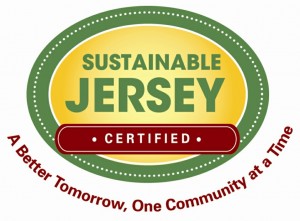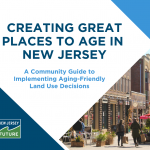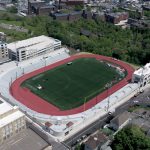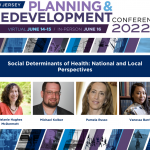New Jersey Future Blog
Community Design for All Ages: A New Sustainable Jersey Municipal Action
May 20th, 2022 by New Jersey Future staff
 Towns enrolled in the Sustainable Jersey program can now get recognition for completing actions that make their communities more livable. The Sustainable Jersey action, Community Design for All Ages, launched in March 2022, offers several ways for municipalities to engage in age-friendly community-building. New Jersey Future participated in the development of the action, which is based on New Jersey Future’s Creating Great Places To Age: A Community Guide to Implementing Aging-Friendly Land Use Decisions.
Towns enrolled in the Sustainable Jersey program can now get recognition for completing actions that make their communities more livable. The Sustainable Jersey action, Community Design for All Ages, launched in March 2022, offers several ways for municipalities to engage in age-friendly community-building. New Jersey Future participated in the development of the action, which is based on New Jersey Future’s Creating Great Places To Age: A Community Guide to Implementing Aging-Friendly Land Use Decisions.
Designing communities to be age-friendly is relevant for municipalities because New Jersey’s population age 65 and older has grown by almost 25% between 2010 and 2019, and by 33% since 2000. With the changing demographics, now is the time to incorporate age-friendly design into New Jersey’s communities.
Municipalities participating in the Sustainable Jersey program understand the importance of sustainable development and take action to support such efforts. Making communities more livable also makes them more sustainable. And by making communities more livable for older adults, we are making them more livable for everyone.
The design and development characteristics that make a community age-friendly are things that benefit all ages—more green spaces; vibrant downtowns; better walkability, bikeability, and mobility; and a variety of housing options that are financially viable and designed for people of all abilities. Below are a few of the opportunities that emerge out of efforts to promote age-friendly communities:
- Mixed-use centers—with people living near businesses— activate commercial and social activity. Livability is good for the economy.
- Access to transportation options promotes social engagement and personal independence, reducing the impacts associated with social isolation affecting those without the ability or desire to drive on busy roads for every trip, or even to drive cars at all. Residents and visitors of all ages should be able to easily get to appointments, employment, shopping, transit, and civic and recreational places without feeling they are putting themselves at risk.
- Diversified housing stock allows people of all ages, ability levels, and incomes to find suitable homes that are less expensive, easier to maintain, and closer to daily destinations and public amenities. For older adults, finding more suitable housing is especially important as their income decreases, their mobility declines, or they want to downsize for easier maintenance and upkeep.
- Amenities such as parks and community centers provide opportunities for exercise and social interaction, notably among older adults who may no longer have opportunities to interact at the workplace.
The Community Design for All Ages action incentivizes towns to address livability in the context of sustainability and offers them robust guidance for implementing development practices and design features that support people of all ages.
The action centers on development of an age-friendly plan and implementation of actions identified in the plan. A main component of the action is to conduct an age-friendly land use assessment. By conducting the assessment, municipalities will evaluate physical features such as sidewalk conditions, street crossings, streetscape improvements, transportation facilities, community facilities, green spaces, and other aspects of the pedestrian environment including access to key destinations in the community. The assessment also evaluates the town’s zoning regulations, looking for regulations that promote mixed-use town centers and a diverse range of housing options, as well as plans and policies that support livability.
Because any local land use effort will be more likely to succeed if it solicits input from the people who will be affected by it, the action also includes a community engagement component. If a municipality chooses to develop an age-friendly implementation plan through this action, community engagement is a requirement.
When municipalities are doing age-friendly work, it is imperative that they do it equitably. New Jersey Future’s report, Creating Great Places to Age for Every Person In Every Neighborhood, evaluates how demographic subgroups in municipalities may be underrepresented in designs, processes, or beneficial outcomes. Municipalities have the capability to address inequities experienced by subgroups through their plans, policies, and regulations. The assessment includes a Demographic Evaluation Tool designed to reveal socioeconomic disparities among neighborhoods that may have resulted from past discriminatory practices, which can then suggest how the age-friendly planning process can be made more inclusive. By conducting intentional and meaningful community engagement, community needs can drive municipal actions and decisions and underrepresented subgroups can have their voices heard and their needs represented. The Community Design for All Ages action provides a framework for municipalities to conduct inclusive surveys or focus groups to gain input.
Improving age-friendliness is gaining traction in New Jersey because we recognize the value and importance of creating places that are healthy, equitable, and sustainable for people of all ages. And as more towns and advocacy organizations have developed plans and strategies for advancing age-friendly development and design, more channels have become available for interested towns to compare notes and to learn from what is working elsewhere. For example, at least 18 communities and one county have joined the AARP Network of Age-Friendly States and Communities, and several communities in northern New Jersey participate in the Age-Friendly North Jersey Alliance. As recognition grows, partnerships and shared learning networks are fueling greater awareness and implementation of age-friendly plans and actions at the local level. The Community Design for All Ages action makes this framework accessible to more communities and highlights its relationship to urban sustainability.
Many places in New Jersey were built in the era of automobile dominance and were not designed with the needs of older residents in mind. The aging of our population makes it imperative to consider those needs now. The Community Design for All Ages action shows what towns can do to ensure they are good, accessible places to live for people of all ages.
Related Posts
Tags: age friendly, aging-friendly, community, creating great places to age in New Jersey, Places to age
















